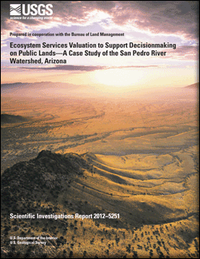This report details the findings of the Bureau of Land Management–U.S. Geological Survey Ecosystem Services Valuation Pilot Study. This project evaluated alternative methods and tools that quantify and value ecosystem services, and it assessed the tools’ readiness for use in the Bureau of Land Management decisionmaking process. We tested these tools on the San Pedro River watershed in northern Sonora, Mexico, and southeast Arizona. The study area includes the San Pedro Riparian National Conservation Area (managed by the Bureau of Land Management), which has been a focal point for conservation activities and scientific research in recent decades. We applied past site-specific primary valuation studies, value transfer, the Wildlife Habitat Benefits Estimation Toolkit, and the Integrated Valuation of Ecosystem Services and Tradeoffs (InVEST) and Artificial Intelligence for Ecosystem Services (ARIES) models to value locally important ecosystem services for the San Pedro River watershed—water, carbon, biodiversity, and cultural values. We tested these approaches on a series of scenarios to evaluate ecosystem service changes and the ability of the tools to accommodate scenarios. A suite of additional tools were either at too early a stage of development to run, were proprietary, or were place-specific tools inappropriate for application to the San Pedro River watershed. We described the strengths and weaknesses of these additional ecosystem service tools against a series of evaluative criteria related to their usefulness for Bureau of Land Management decisionmaking. Using these tools, we quantified gains or losses of ecosystem services under three categories of scenarios: urban growth, mesquite management, and water augmentation. These results quantify tradeoffs and could be useful for decisionmaking within Bureau of Land Management district or field offices. Results are accompanied by a relatively high level of uncertainty associated with model outputs, valuation methods, and discount rates applied. Further guidance on representing uncertainty and applying uncertain results in decisionmaking would benefit both tool developers and those offices in using ecosystem services to compare management tradeoffs. Decisionmakers and Bureau of Land Management managers at the State-, district-, and field-office level would also benefit from continuing model improvements, training, and guidance on tool use that can be provided by the U.S. Geological Survey, the Bureau of Land Management, and the Department of the Interior. Tradeoffs were identified in the level of effort needed to parameterize and run tools and the amount and quality of information they provide to the decision process. We found the Wildlife Habitat Benefits Estimation Toolkit, Ecosystem Services Review, and United Nations Environment Programme–World Conservation Monitoring Centre Ecosystem Services Toolkit to be immediately feasible for application by the Bureau of Land Management, given proper guidance on their use. It is also feasible for the Bureau of Land Management to use the InVEST model, but in early 2012 the process of parameterizing the model required resources and expertise that are unlikely to be available in most Bureau of Land Management district or field offices. Application of past primary valuation is feasible, but developing new primary-valuation studies is too time consuming for regular application. Value transfer approaches (aside from the Wildlife Habitat Benefits Estimation Toolkit) are best applied carefully on the basis of guidelines described in this report, to reduce transfer error. The ARIES model can provide useful information in regions modeled in the past (Arizona, California, Colorado, and Washington), but it lacks some features that will improve its usability, such as a generalized model that could be applied anywhere in the United States. Eleven other tools described in this report could become useful as the tools more fully develop, in high-profile cases for which additional resources are available for tool application or in case-study regions where place-specific models have already been developed. To improve the value of these tools in decisionmaking, we suggest scientific needs that agencies such as U.S. Geological Survey can help meet—for instance, development and support of data archives. Such archives could greatly reduce resource needs and improve the reliability and consistency of results. Given the rapid state of evolution in the field, periodic follow-up studies on ecosystem services tools would help to ensure that the Bureau of Land Management and other public land management agencies are kept up to date on new tools and features that bring ecosystem services closer to readiness for use in regular decisionmaking.


